+ Open data
Open data
- Basic information
Basic information
| Entry | Database: EMDB / ID: EMD-30238 | |||||||||
|---|---|---|---|---|---|---|---|---|---|---|
| Title | CLC-7/Ostm1 membrane protein complex | |||||||||
 Map data Map data | ||||||||||
 Sample Sample |
| |||||||||
 Keywords Keywords | complex / lysosome / transporter / MEMBRANE PROTEIN | |||||||||
| Function / homology |  Function and homology information Function and homology informationtransepithelial chloride transport / chloride:proton antiporter activity / response to pH / chloride transmembrane transporter activity / chloride channel activity / chloride channel complex / osteoclast differentiation / Stimuli-sensing channels / lysosomal membrane / intracellular membrane-bounded organelle ...transepithelial chloride transport / chloride:proton antiporter activity / response to pH / chloride transmembrane transporter activity / chloride channel activity / chloride channel complex / osteoclast differentiation / Stimuli-sensing channels / lysosomal membrane / intracellular membrane-bounded organelle / ATP binding / membrane / cytosol Similarity search - Function | |||||||||
| Biological species |  Homo sapiens (human) Homo sapiens (human) | |||||||||
| Method | single particle reconstruction / cryo EM / Resolution: 3.7 Å | |||||||||
 Authors Authors | Zhang SS / Yang MJ | |||||||||
| Funding support |  China, 1 items China, 1 items
| |||||||||
 Citation Citation |  Journal: Sci Adv / Year: 2020 Journal: Sci Adv / Year: 2020Title: Molecular insights into the human CLC-7/Ostm1 transporter. Authors: Sensen Zhang / Yang Liu / Bing Zhang / Jun Zhou / Tianyu Li / Zhiqiang Liu / Yang Li / Maojun Yang /  Abstract: CLC family proteins translocate chloride ions across cell membranes to maintain the membrane potential, regulate the transepithelial Cl transport, and control the intravesicular pH among different ...CLC family proteins translocate chloride ions across cell membranes to maintain the membrane potential, regulate the transepithelial Cl transport, and control the intravesicular pH among different organelles. CLC-7/Ostm1 is an electrogenic Cl/H antiporter that mainly resides in lysosomes and osteoclast ruffled membranes. Mutations in human CLC-7/Ostm1 lead to lysosomal storage disorders and severe osteopetrosis. Here, we present the cryo-electron microscopy (cryo-EM) structure of the human CLC-7/Ostm1 complex and reveal that the highly glycosylated Ostm1 functions like a lid positioned above CLC-7 and interacts extensively with CLC-7 within the membrane. Our complex structure reveals a functionally crucial domain interface between the amino terminus, TMD, and CBS domains of CLC-7. Structural analyses and electrophysiology studies suggest that the domain interaction interfaces affect the slow gating kinetics of CLC-7/Ostm1. Thus, our study deepens understanding of CLC-7/Ostm1 transporter and provides insights into the molecular basis of the disease-related mutations. | |||||||||
| History |
|
- Structure visualization
Structure visualization
| Movie |
 Movie viewer Movie viewer |
|---|---|
| Structure viewer | EM map:  SurfView SurfView Molmil Molmil Jmol/JSmol Jmol/JSmol |
| Supplemental images |
- Downloads & links
Downloads & links
-EMDB archive
| Map data |  emd_30238.map.gz emd_30238.map.gz | 6 MB |  EMDB map data format EMDB map data format | |
|---|---|---|---|---|
| Header (meta data) |  emd-30238-v30.xml emd-30238-v30.xml emd-30238.xml emd-30238.xml | 11.3 KB 11.3 KB | Display Display |  EMDB header EMDB header |
| Images |  emd_30238.png emd_30238.png | 204.6 KB | ||
| Filedesc metadata |  emd-30238.cif.gz emd-30238.cif.gz | 5.8 KB | ||
| Archive directory |  http://ftp.pdbj.org/pub/emdb/structures/EMD-30238 http://ftp.pdbj.org/pub/emdb/structures/EMD-30238 ftp://ftp.pdbj.org/pub/emdb/structures/EMD-30238 ftp://ftp.pdbj.org/pub/emdb/structures/EMD-30238 | HTTPS FTP |
-Validation report
| Summary document |  emd_30238_validation.pdf.gz emd_30238_validation.pdf.gz | 444.1 KB | Display |  EMDB validaton report EMDB validaton report |
|---|---|---|---|---|
| Full document |  emd_30238_full_validation.pdf.gz emd_30238_full_validation.pdf.gz | 443.7 KB | Display | |
| Data in XML |  emd_30238_validation.xml.gz emd_30238_validation.xml.gz | 5.7 KB | Display | |
| Data in CIF |  emd_30238_validation.cif.gz emd_30238_validation.cif.gz | 6.5 KB | Display | |
| Arichive directory |  https://ftp.pdbj.org/pub/emdb/validation_reports/EMD-30238 https://ftp.pdbj.org/pub/emdb/validation_reports/EMD-30238 ftp://ftp.pdbj.org/pub/emdb/validation_reports/EMD-30238 ftp://ftp.pdbj.org/pub/emdb/validation_reports/EMD-30238 | HTTPS FTP |
-Related structure data
| Related structure data |  7bxuMC M: atomic model generated by this map C: citing same article ( |
|---|---|
| Similar structure data |
- Links
Links
| EMDB pages |  EMDB (EBI/PDBe) / EMDB (EBI/PDBe) /  EMDataResource EMDataResource |
|---|---|
| Related items in Molecule of the Month |
- Map
Map
| File |  Download / File: emd_30238.map.gz / Format: CCP4 / Size: 30.5 MB / Type: IMAGE STORED AS FLOATING POINT NUMBER (4 BYTES) Download / File: emd_30238.map.gz / Format: CCP4 / Size: 30.5 MB / Type: IMAGE STORED AS FLOATING POINT NUMBER (4 BYTES) | ||||||||||||||||||||||||||||||||||||||||||||||||||||||||||||
|---|---|---|---|---|---|---|---|---|---|---|---|---|---|---|---|---|---|---|---|---|---|---|---|---|---|---|---|---|---|---|---|---|---|---|---|---|---|---|---|---|---|---|---|---|---|---|---|---|---|---|---|---|---|---|---|---|---|---|---|---|---|
| Projections & slices | Image control
Images are generated by Spider. | ||||||||||||||||||||||||||||||||||||||||||||||||||||||||||||
| Voxel size | X=Y=Z: 1.08 Å | ||||||||||||||||||||||||||||||||||||||||||||||||||||||||||||
| Density |
| ||||||||||||||||||||||||||||||||||||||||||||||||||||||||||||
| Symmetry | Space group: 1 | ||||||||||||||||||||||||||||||||||||||||||||||||||||||||||||
| Details | EMDB XML:
CCP4 map header:
| ||||||||||||||||||||||||||||||||||||||||||||||||||||||||||||
-Supplemental data
- Sample components
Sample components
-Entire : lysosomal membrane protein complex
| Entire | Name: lysosomal membrane protein complex |
|---|---|
| Components |
|
-Supramolecule #1: lysosomal membrane protein complex
| Supramolecule | Name: lysosomal membrane protein complex / type: complex / ID: 1 / Parent: 0 / Macromolecule list: #1-#2 |
|---|---|
| Source (natural) | Organism:  Homo sapiens (human) Homo sapiens (human) |
-Macromolecule #1: Osteopetrosis-associated transmembrane protein 1
| Macromolecule | Name: Osteopetrosis-associated transmembrane protein 1 / type: protein_or_peptide / ID: 1 / Number of copies: 2 / Enantiomer: LEVO |
|---|---|
| Source (natural) | Organism:  Homo sapiens (human) Homo sapiens (human) |
| Molecular weight | Theoretical: 37.29057 KDa |
| Recombinant expression | Organism:  Homo sapiens (human) Homo sapiens (human) |
| Sequence | String: MEPGPTAAQR RCSLPPWLPL GLLLWSGLAL GALPFGSSPH RVFHDLLSEQ QLLEVEDLSL SLLQGGGLGP LSLPPDLPDL DPECRELLL DFANSSAELT GCLVRSARPV RLCQTCYPLF QQVVSKMDNI SRAAGNTSES QSCARSLLMA DRMQIVVILS E FFNTTWQE ...String: MEPGPTAAQR RCSLPPWLPL GLLLWSGLAL GALPFGSSPH RVFHDLLSEQ QLLEVEDLSL SLLQGGGLGP LSLPPDLPDL DPECRELLL DFANSSAELT GCLVRSARPV RLCQTCYPLF QQVVSKMDNI SRAAGNTSES QSCARSLLMA DRMQIVVILS E FFNTTWQE ANCANCLTNN SEELSNSTVY FLNLFNHTLT CFEHNLQGNA HSLLQTKNYS EVCKNCREAY KTLSSLYSEM QK MNELENK AEPGTHLCID VEDAMNITRK LWSRTFNCSV PCSDTVPVIA VSVFILFLPV VFYLSSFLHS EQKKRKLILP KRL KSSTSF ANIQENSN UniProtKB: Osteopetrosis-associated transmembrane protein 1 |
-Macromolecule #2: H(+)/Cl(-) exchange transporter 7
| Macromolecule | Name: H(+)/Cl(-) exchange transporter 7 / type: protein_or_peptide / ID: 2 / Number of copies: 2 / Enantiomer: LEVO |
|---|---|
| Source (natural) | Organism:  Homo sapiens (human) Homo sapiens (human) |
| Molecular weight | Theoretical: 88.773875 KDa |
| Recombinant expression | Organism:  Homo sapiens (human) Homo sapiens (human) |
| Sequence | String: MANVSKKVSW SGRDRDDEEA APLLRRTARP GGGTPLLNGA GPGAARQSPR SALFRVGHMS SVELDDELLD PDMDPPHPFP KEIPHNEKL LSLKYESLDY DNSENQLFLE EERRINHTAF RTVEIKRWVI CALIGILTGL VACFIDIVVE NLAGLKYRVI K GNIDKFTE ...String: MANVSKKVSW SGRDRDDEEA APLLRRTARP GGGTPLLNGA GPGAARQSPR SALFRVGHMS SVELDDELLD PDMDPPHPFP KEIPHNEKL LSLKYESLDY DNSENQLFLE EERRINHTAF RTVEIKRWVI CALIGILTGL VACFIDIVVE NLAGLKYRVI K GNIDKFTE KGGLSFSLLL WATLNAAFVL VGSVIVAFIE PVAAGSGIPQ IKCFLNGVKI PHVVRLKTLV IKVSGVILSV VG GLAVGKE GPMIHSGSVI AAGISQGRST SLKRDFKIFE YFRRDTEKRD FVSAGAAAGV SAAFGAPVGG VLFSLEEGAS FWN QFLTWR IFFASMISTF TLNFVLSIYH GNMWDLSSPG LINFGRFDSE KMAYTIHEIP VFIAMGVVGG VLGAVFNALN YWLT MFRIR YIHRPCLQVI EAVLVAAVTA TVAFVLIYSS RDCQPLQGGS MSYPLQLFCA DGEYNSMAAA FFNTPEKSVV SLFHD PPGS YNPLTLGLFT LVYFFLACWT YGLTVSAGVF IPSLLIGAAW GRLFGISLSY LTGAAIWADP GKYALMGAAA QLGGIV RMT LSLTVIMMEA TSNVTYGFPI MLVLMTAKIV GDVFIEGLYD MHIQLQSVPF LHWEAPVTSH SLTAREVMST PVTCLRR RE KVGVIVDVLS DTASNHNGFP VVEHADDTQP ARLQGLILRS QLIVLLKHKV FVERSNLGLV QRRLRLKDFR DAYPRFPP I QSIHVSQDER ECTMDLSEFM NPSPYTVPQE ASLPRVFKLF RALGLRHLVV VDNRNQVVGL VTRKDLARYR LGKRGLEEL SLAQT UniProtKB: H(+)/Cl(-) exchange transporter 7 |
-Macromolecule #3: 2-acetamido-2-deoxy-beta-D-glucopyranose
| Macromolecule | Name: 2-acetamido-2-deoxy-beta-D-glucopyranose / type: ligand / ID: 3 / Number of copies: 14 / Formula: NAG |
|---|---|
| Molecular weight | Theoretical: 221.208 Da |
| Chemical component information |  ChemComp-NAG: |
-Experimental details
-Structure determination
| Method | cryo EM |
|---|---|
 Processing Processing | single particle reconstruction |
| Aggregation state | particle |
- Sample preparation
Sample preparation
| Buffer | pH: 7.2 |
|---|---|
| Vitrification | Cryogen name: ETHANE |
- Electron microscopy
Electron microscopy
| Microscope | FEI TITAN KRIOS |
|---|---|
| Image recording | Film or detector model: GATAN K2 SUMMIT (4k x 4k) / Average electron dose: 50.0 e/Å2 |
| Electron beam | Acceleration voltage: 300 kV / Electron source:  FIELD EMISSION GUN FIELD EMISSION GUN |
| Electron optics | Illumination mode: FLOOD BEAM / Imaging mode: BRIGHT FIELD |
| Experimental equipment |  Model: Titan Krios / Image courtesy: FEI Company |
- Image processing
Image processing
| Startup model | Type of model: OTHER |
|---|---|
| Final reconstruction | Applied symmetry - Point group: C2 (2 fold cyclic) / Resolution.type: BY AUTHOR / Resolution: 3.7 Å / Resolution method: FSC 0.143 CUT-OFF / Number images used: 3956 |
| Initial angle assignment | Type: OTHER |
| Final angle assignment | Type: OTHER |
 Movie
Movie Controller
Controller



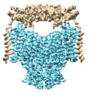



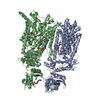
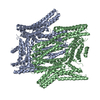
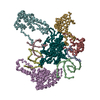


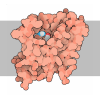
 Z (Sec.)
Z (Sec.) Y (Row.)
Y (Row.) X (Col.)
X (Col.)





















